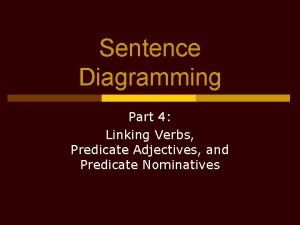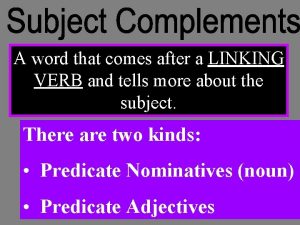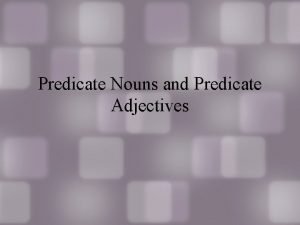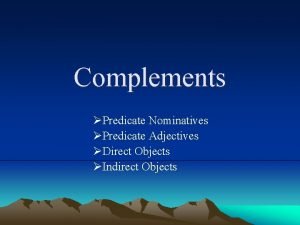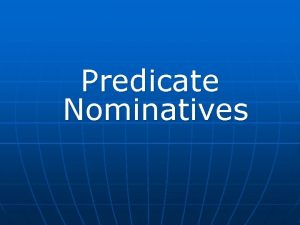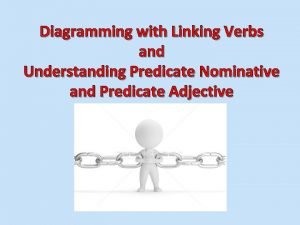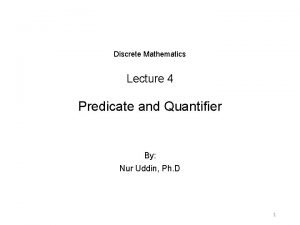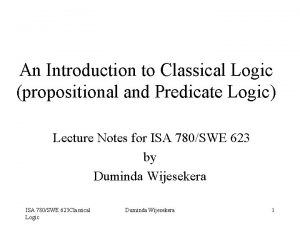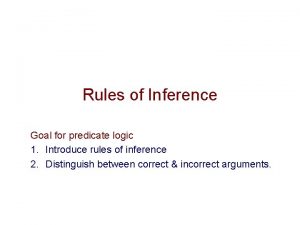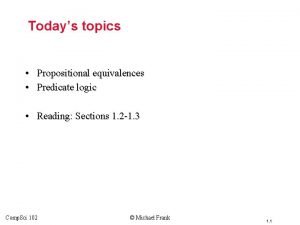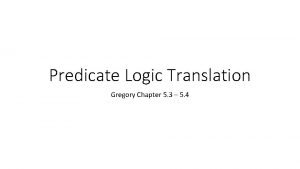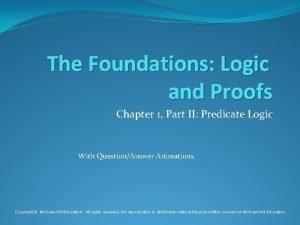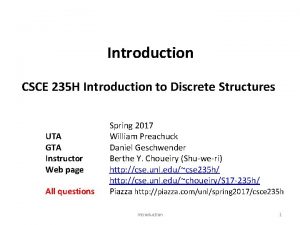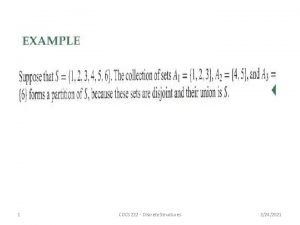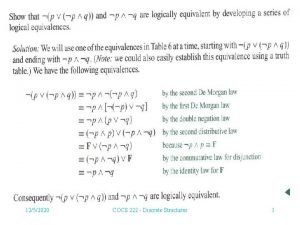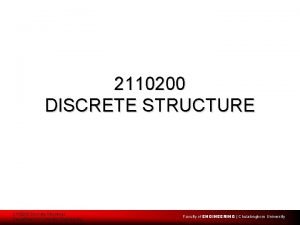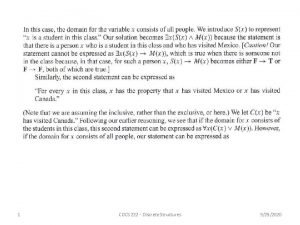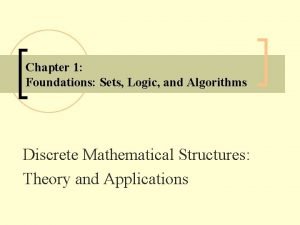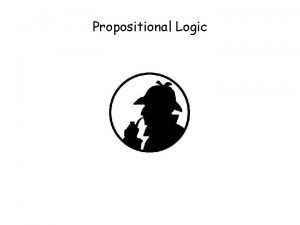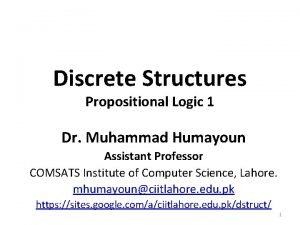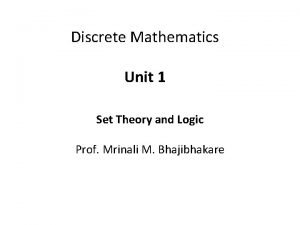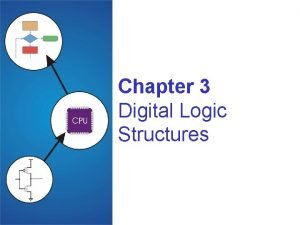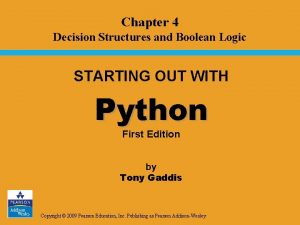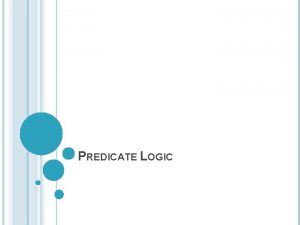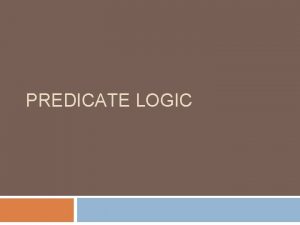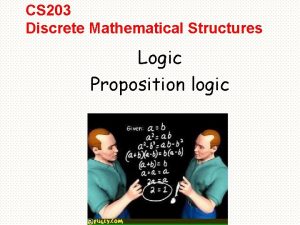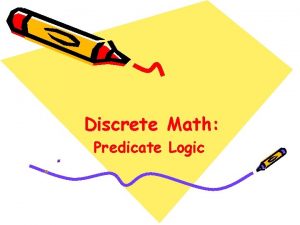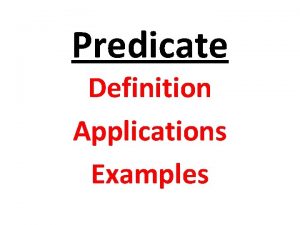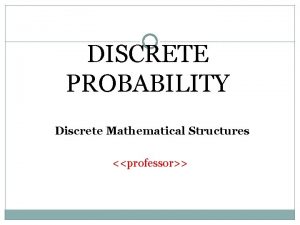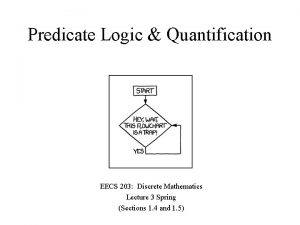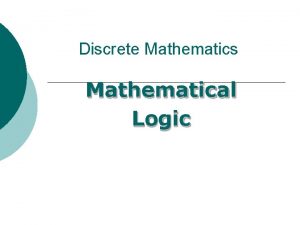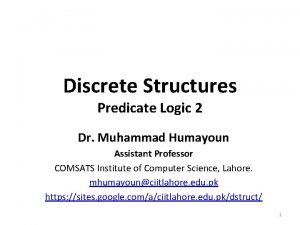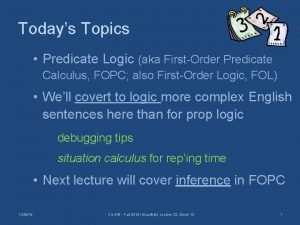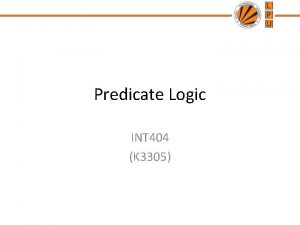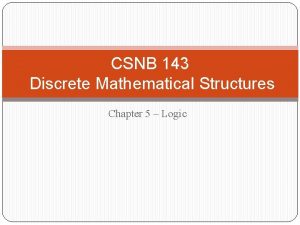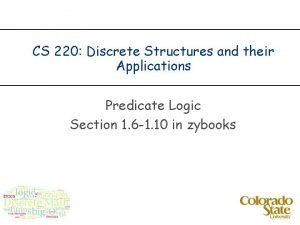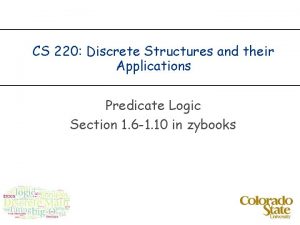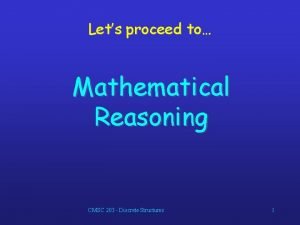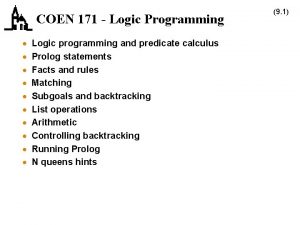CS 203 Discrete Mathematical Structures Logic 2 Predicate








































- Slides: 40

CS 203 Discrete Mathematical Structures Logic (2)

Predicate Logic - everybody loves somebody Proposition, YES or NO? 3+2=5 YES X+2=5 NO X + 2 = 5 for any choice of X in {1, 2, 3} X + 2 = 5 for some X in {1, 2, 3} YES

Predicates Ahmed eats pizza at least once a week. … Define: EP(x) = “x eats pizza at least once a week. ” Universe of Discourse - x is a student in CS 203 A predicate is a function that takes some variable(s) as arguments and returns True or False. Note that EP(x) is not a proposition, EP(Hassan) is.

Predicates A predicate is a property or description of subjects in the universe of discourse. The following predicates are all italicized : – Johnny is tall. – The bridge is structurally sound. – 17 is a prime number. Java: predicates are boolean-valued method calls– some. Linked. List. is. Empty() – is. Prime(17)

Quantifiers There are two quantifiers • Existential Quantifier “ ” reads “there exists” • Universal Quantifier “ ” reads “for all” Each is placed in front of a propositional function and binds it to obtain a proposition with semantic value.

Predicates - the universal quantifier Suppose P(x) is a predicate on some universe of discourse. Ex. B(x) = “x is carrying a backpack, ” x is set of CS 203 students. The universal quantifier of P(x) is the proposition: “P(x) is true for all x in the universe of discourse. ” We write it x P(x), and say “for all x, P(x)” x P(x) is TRUE if P(x) is true for every single x. x P(x) is FALSE if there is an x for which P(x) is x B(x)? false.

Predicates - the existential quantifier Suppose P(x) is a predicate on some universe of discourse. Ex. C(x) = “x has a cat, ” x is set of CS 203 students. The existential quantifier of P(x) is the proposition: “P(x) is true for some x in the universe of discourse. ” We write it x P(x), and say “for some x, P(x)” x P(x) is TRUE if there is an x for which P(x) is true. x C(x)? x P(x) is FALSE if P(x) is false for every single x.

Predicates - the existential quantifier Universe of discourse is people in this room. B(x) = “x is wearing sneakers. ” L(x) = “x is at least 16 years old. ” Y(x)= “x is less than 24 years old. ” Are either of these propositions true? a) b) x B(x) x (Y(x) L(x)) A: only a is true B: only b is true C: both are true D: neither is true

Predicates - more examples L(x) = “x is a lion. ” Universe of discourse is all creatures. F(x) = “x is fierce. ” C(x) = “x drinks coffee. ” All lions are fierce. Some lions don’t drink coffee. x (L(x) F(x)) x (L(x) C(x)) Some fierce creatures don’t drink coffee. x (F(x) C(x))

Predicates - more examples B(x) = “x is a hummingbird. ” L(x) = “x is a large bird. ” H(x) = “x lives on honey. ” R(x) = “x is richly colored. ” Universe of discourse is all creatures. All hummingbirds are richly colored. No large birds live on honey. x (B(x) R(x)) x (L(x) H(x)) Birds that do not live on honey are dully colored. x ( H(x) R(x))

Fundamentals of Logic The Use of Quantifiers Ex universe: real numbers x=4 x=1 x=5, 6, . . x=-1

Predicates - the universal quantifier Universe of discourse is people in this Hall. B(x) = “x is wearing sneakers. ” L(x) = “x is at least 18 years old. ” Y(x)= “x is less than 24 years old. ” Are either of these propositions true? a) b) x (Y(x) B(x)) x (Y(x) L(x)) A: only a is true B: only b is true C: both are true D: neither is true

Predicates - quantifier negation Not all large birds live on honey. x (L(x) H(x)) x P(x) means “P(x) is true for every x. ” What about x P(x) ? Not [“P(x) is true for every x. ”] “There is an x for which P(x) is not true. ” x P(x) So, x P(x) is the same as x P(x). x (L(x) H(x))

Predicates - quantifier negation No large birds live on honey. x (L(x) H(x)) x P(x) means “P(x) is true for some x. ” What about x P(x) ? Not [“P(x) is true for some x. ”] “P(x) is not true for all x. ” x P(x) So, x P(x) is the same as x P(x). x (L(x) H(x))

Predicates - quantifier negation So, x P(x) is the same as x P(x). General rule: to negate a quantifier, move negation to the right, changing quantifiers as you go.

Fundamentals of Logic Ex. p(x): x is odd. q(x): x 2 -1 is even. Negate (If x is odd, then x 2 -1 is even. ) There exists an integer x such that x is odd and x 2 -1 is odd. (a false statement, the original is true)

Predicates - quantifier negation No large birds live on honey. x (L(x) H(x)) Negation rule x ( L(x) H(x)) De. Morgan’s x (L(x) H(x)) Subst for What’s wrong with this proof?

Fundamentals of Logic multiple variables

Fundamentals of Logic BUT Ex. p(x, y): x+y=17. : For every integer x, there exists an integer y such that x+y=17. (TRUE) : There exists an integer y so that for all integer x, x+y=17. (FALSE) Therefore,

Order matters Set the universe of discourse to be all natural numbers {0, 1, 2, 3, … }. Let R (x, y ) = “x < y”. Q 1: What does x y R (x, y ) mean? Q 2: What does y x R (x, y ) mean? 20

Order matters R (x, y ) = “x < y” A 1: x y R (x, y ): “All numbers x admit a bigger number y ” A 2: y x R (x, y ): “Some number y is bigger than all x” Q: What’s the true value of each expression? 21

More Practice for Predicate Logic • Nermin likes all movies that Rehab likes (and possibly more). • x [Movie(x) Likes(Rehab, x) Likes(Nermin, x)] • There is exactly one AU professor who won a Nobel prize • x[AU_Prof(x) Wins(x, Nobel. Prize)] y, z[y z AU_Prof(y) AU_Prof(z) Wins(y, Nobel. Prize) Wins(z, Nobel. Prize)]

Review of Boolean algebra • Not is a horizontal bar above the number – 0=1 – 1=0 • Or is a plus – – 0+0 = 0 0+1 = 1 1+0 = 1 1+1 = 1 • And is multiplication – – – 23 – 0*0 = 0 0*1 = 0 1*0 = 0 1*1 = 1

NOT Logic Gate: A A’ or -A Truth Table: (also called an inverter) Single-throw Double-pole Switch: • Y = ~X Y = X’ A A’ or -A Y = !X not(Y, X) A 0 1 -A 1 0 Y = not X

AND Logic Gate: A A*B B A B Series Circuit: A*B Truth Table: A 0 0 1 B 0 1 0 A*B 0 0 0 1 1 1

AND • X & Y (Verilog and ABEL) • X and Y (VHDL) • X Y • X * Y • XY (textbook) • and(Z, X, Y) (Verilog) V U

OR Logic Gate: A A+B B A Parallel Circuit: B A+B Truth Table: A 0 0 1 B 0 1 0 A+B 0 1 1 1

OR • X | Y • X # Y • X or Y • X + Y • X V Y • X U Y • or(Z, X, Y) (Verilog) (ABEL) (VHDL) (textbook) (Verilog)

NAND Gate NAND X Z Y Z = ~(X & Y) nand(Z, X, Y) X 0 0 1 1 Y 0 1 Z 1 1 1 0

NOR Gate NOR X Y Z = ~(X | Y) nor(Z, X, Y) Z X 0 0 1 1 Y 0 1 Z 1 0 0 0

Exclusive-OR Gate XOR X Z Y Z = X ^ Y xor(Z, X, Y) X Y Z 0 0 1 1 0 0 1

XOR • X ^ Y • X $ Y • X @ Y (Verilog) (ABEL) • xor(Z, X, Y) (Verilog)

Logic Circuits ≡ Boolean Expressions A B C • All logic circuits are equivalent to Boolean expressions and any boolean • • AND-OR logic circuits are equivalent to sum-of-products form. Consider the following circuits: expression can be rendered as a logic circuit. y=a. B+Bc abc a. Bc y Ab y=abc+a. Bc+Ab A B C Y

question • Find the output of the following circuit x+y (x+y)y y __ • Answer: (x+y)y__ 34 – Or (x y) y

question • Write the circuits for the following Boolean algebraic expressions _______ • (x+y)x x+y (x+y)x

Draw a circuit diagram for = (xy' + x'y)z. 36

37

38

• • Let’s compare the resulting Here are two circuits different but equivalent circuits. In general the one with fewer gates is “better”: – It costs less to build – It requires less power – But we had to do some work to find the second form

 Predicate nominative and predicate adjective
Predicate nominative and predicate adjective Predicate adjective
Predicate adjective Predicate noun examples
Predicate noun examples Predicate nominative and predicate adjective
Predicate nominative and predicate adjective Sentence with predicate nominative
Sentence with predicate nominative Complete predicate and simple predicate
Complete predicate and simple predicate Predicate adjective and predicate nominative
Predicate adjective and predicate nominative Predicate discrete math
Predicate discrete math Mathematical economics vs non mathematical economics
Mathematical economics vs non mathematical economics The first order chapter 8
The first order chapter 8 Reflexive axiom
Reflexive axiom Predicate negation
Predicate negation Only one student failed in mathematics fol
Only one student failed in mathematics fol Predicate logic rules of inference
Predicate logic rules of inference Predicate logic equivalence
Predicate logic equivalence Predicate logic translator
Predicate logic translator What is predicate logic example
What is predicate logic example Discrete structures
Discrete structures Discrete structures
Discrete structures Discrete computational structures
Discrete computational structures Proof by contradiction discrete math
Proof by contradiction discrete math Discrete structures
Discrete structures 2110200
2110200 Cs 584
Cs 584 Mathematical logic laws
Mathematical logic laws Mathematical logic
Mathematical logic Mathematical logic formula
Mathematical logic formula Discrete math propositional logic
Discrete math propositional logic Proposition in mathematics
Proposition in mathematics Application of propositional logic in discrete mathematics
Application of propositional logic in discrete mathematics Discrete math set theory
Discrete math set theory Example of homologous structure
Example of homologous structure Digital logic structures
Digital logic structures Python decision structures
Python decision structures First order logic vs propositional logic
First order logic vs propositional logic Majority circuit
Majority circuit Concurrent vs sequential
Concurrent vs sequential Combinational logic sequential logic 차이
Combinational logic sequential logic 차이 First order logic vs propositional logic
First order logic vs propositional logic Cryptarithmetic problem logic+logic=prolog
Cryptarithmetic problem logic+logic=prolog Logic chapter 3
Logic chapter 3
